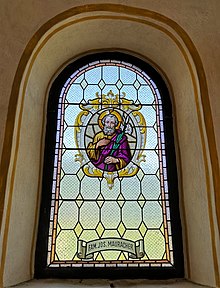Schreckbichl
Schreckbichl (more rarely Schreckbühel ) is a district of Girlan , a fraction of the municipality of Appiano in South Tyrol ( Italy ) located near Bolzano . The scattered settlement is at 486 m slm slightly higher than the Girlaner town center on the northern foothills of the Mitterberg (at the transition to the Kaiserberg ) and is dominated south by the Wilder-Mann-Bühel ( 639 m slm ).
The place is important in terms of wine industry and is known nationwide thanks to the Schreckbichl winery .
Surname
The place name derives from the Old High German scrēcchôn meaning “to jump” and “ scare ” (“outstanding rock ”), meaning a settlement on an outstanding elevation. In 1355, with Chunradus dictus Geislitz de Niderschrechpuhel , the district of Niederschreckbichl, which has since disappeared, is documented.
history
Schreckbichl was first mentioned in the 12th century. The earliest mention is due to a traditional note of the wealthy Baumburg monastery from the years 1139–1145, in which a Wernhere de Screcbuhilen appears as a witness. The location is also in the entire Tyrolean Urbar Count Meinhard II. Of 1288 as ze Schrekelpuhel named because the prince decreed here on taxable property. A list of members of the community of Girlan and of Schreckbichl ( universitas ville Guerlan et loci Schreckpuhel ) has been handed down from 1324 , in which representatives of the community cede common land to the Stams monastery .
Attractions
The center of the village is determined by the Holy Cross Chapel dating from the early 19th century. The simple building with a straight choir, lunette and arched windows was supplemented and assigned a bell tower in 1823 . The frescoes with St. Urban (on the ceiling), the Lamb of God and the Crucifixion of Christ (in the apse ) are by Albert Stolz and were executed in 1937. The church was listed as a historical monument in 1977 .
The townscape is largely determined by wine yards , including the Fischer, the Harrer, the Ebner and the Marklhof, the latter once owned by Steingaden Monastery and today by Neustift Monastery .
Individual evidence
- ^ Egon Kühebacher : The place names of South Tyrol and their history. Volume 1. Bozen: Athesia 1991. ISBN 88-7014-634-0 , p. 424.
- ^ Hannes Obermair : Bozen Süd - Bolzano Nord. Written form and documentary tradition of the city of Bozen up to 1500 . tape 1 . City of Bozen, Bozen 2005, ISBN 88-901870-0-X , p. 331, no. 668 .
- ^ Franz Huter (edit.): Tyrolean document book . Section I, Volume 1. Innsbruck: Wagner 1937, pp. 74f., No. 167a.
- ↑ Oswald Zingerle (ed.): Meinhards II. Urbare der Grafschaft Tirol (Fontes Rerum Austriacarum, Diplomataria et acta 55 / I). Vienna 1890, § XXIV, No. 53.
- ^ Otto Stolz : The expansion of Germanness in South Tyrol in the light of the documents. Volume 3/2. Oldenbourg: Munich 1932, pp. 106-107, no. 31.
- ^ Josef Weingartner : The art monuments of South Tyrol. Volume 2: Bozen and surroundings, Unterland, Burggrafenamt, Vinschgau. 7th edition, edit. by Magdalena Hörmann-Weingartner. Bozen-Innsbruck-Vienna: Athesia-Tyrolia 1991. ISBN 88-7014-642-1 , p. 270.
Web links
- Entry in the monument browser on the website of the South Tyrolean Monuments Office
Coordinates: 46 ° 27 ' N , 11 ° 18' E

